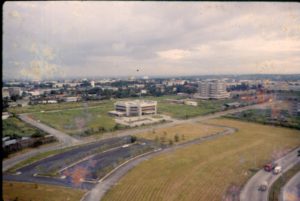By Mr. Daryl Zamora
This article was first published in the July 2009 print issue of Universitas.
“…I’ll place a martyrdom within your reach: to be an apostle and not call yourself an apostle, to be a missionary—with a mission—and not call yourself a missionary, to be a man of God and to seem a man of the world: to pass unnoticed!” —St. Josemaría Escrivá, The Way, 848
The year was 1970, and Harvard donned its springtime regalia.
Dr. Jesus Estanislao—who in 1967 had just co-founded UA&P’s forerunner, the Center for Research and Communication (CRC)—was talking to a young economist like himself. The conversation revolved around the nascent apostolate of Opus Dei in the Philippines and the early activities of CRC. Dr. Estanislao was trying to invite his friend to come to the Philippines and help out.
The conversation did not have to take long; Mr. Robert “Bob” Paluszka immediately accepted the offer. 
Last June 8, Mr. Paluszka passed away at 70 years old—after 39 years in the Philippines spent on hard work, helping build or rehabilitate companies, making friends and keeping them, and dedicating all his efforts to the noblest of ideals.
Very few at UA&P today know him. Hardly anyone knows that—as Dr. Estanislao said in the eulogy he delivered at Mr. Paluszka’s funeral—the former US Marine officer had been the one “most directly instrumental in setting up the Information Center of CRC… the very heart of a center that needed facts and figures, systematically collected, stored, and made ready for easy access and professional analysis.”
“In this regard,” continued Dr. Estanislao, “Bob made it possible for CRC to build itself up as one of the most credible sources of economic and industry analysis in the country, even during its initial years….He oversaw articles that our young staff would write, on the basis of facts and figures he helped analyze… and most of these ended up published in the papers then allowed to be circulated even during the Martial Law years. This gave CRC professional prestige, the hook with which it could catch men and women decision-makers by their heads.”
All that fruit came from the hours of intense work in the silence of Mr. Paluszka’s office. He was among the hidden pillars that supported the great edifice that was CRC.

Larger than life
Mr. Paluszka held graduate degrees in accounting and economics from Bentley College and Georgetown University, respectively. While his technical expertise and dedication to the foundational work at CRC was unquestionable, Mr. Paluszka was truly larger than life. “Thoroughness, toughness, and competence wonderfully combined with friendship, care, and affection,” said Dr. Estanislao, “these Bob brought to everyone he dealt with and worked with at CRC’s Information Center, and into the boys of the youth club he pioneered.”
Where did Mr. Paluszka get all that diligence and love? Dr. Estanislao concluded his eulogy by answering this question thus:
“[Bob] had told [us] some two months before he finally breathed his last that he was suffering from great, intense pain. As usual, he hid it as best he could. When [some of us] visited him at the hospital some two weeks ago, he did wake up from his slumber, and he gave [us] the most angelic of smiles I have ever seen.
“Why the smile? [In the oratory of the house where we live], we have a beautiful statue of Our Lady with the Child Jesus sitting on Mary’s lap, with an open book on the Child’s hands. In a talk that Bob gave, he once described that statue in terms I could never forget. He said: our Lady’s eyes were not on the book, but on the Child.
Bob’s eyes, in his life and work, were not on the books and papers and files, but on the Child. Smile on, Bob, forever!”
Mr. Daryl Zamora worked with the Corporate Communications Office of UA&P.
Banner photo by Mauricio Artieda on Unsplash.
Leave a Reply